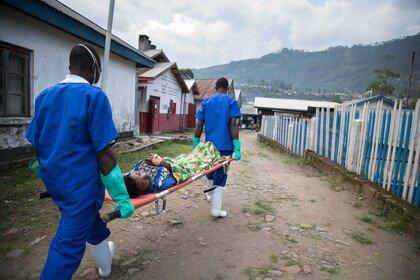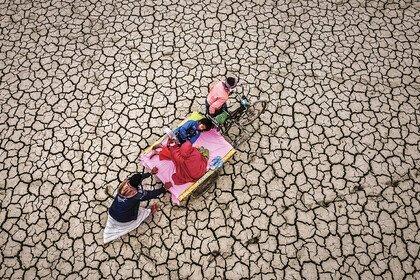
The link between climate change and infectious disease
A failure to slow global warming is providing many deadly diseases with the opportunity to expand their reach, putting the health of millions of people at risk. Read on to understand more.
As climate change alters temperatures and weather patterns around the world, the risk of vector-borne diseases like malaria, dengue fever and Zika virus will increase. Here’s what that means for global health and what can be done to limit the damage.

Adrienne Surprenant / Agence MYOP, Wellcome
In response to a confirmed case of dengue nearby, Dominique, 44, from the French governmental health agency ARS Indian Ocean, sprays the insecticide deltamethrin in the gardens around Piton Saint-Leu to prevent adult mosquitoes from spreading the virus.
The insecticide is carefully tested and adjusted to stop the mosquitoes from developing resistance. ARS Indian Ocean is a leading agency in the response to epidemics of arboviruses (diseases spread by mosquitoes, fleas or ticks) or other priority diseases in French overseas territories, such as La Réunion.
Virtually all vector-borne diseases have a climate dimension.
An additional 4.7 billion people may be at risk of the vector-borne diseases malaria and dengue by 2070.
Global warming can extend the geographic spread of vectors and the disease transmission season.
Increased rainfall and drought can increase the amount of standing water, creating more breeding areas for vectors.
Some areas will become too hot for vectors to survive.
However, linking these impacts directly to climate change can be challenging, as other factors are also at play (like changes in land use and human movement).
The sooner we act to mitigate and adapt to the impacts of climate change the better off we’ll be in the future.
Vector-borne diseases are caused by pathogens that have been transmitted from an infected animal to a human by a vector (a living organism, like a tick or mosquito). Examples of vector-borne diseases include dengue, Zika virus, malaria, Chikungunya and yellow fever.
Virtually all vector-borne diseases have a climate dimension.
The pathogens, vectors and hosts associated with vector-borne diseases are highly responsive to the environments they inhabit. This means that changes in temperature and precipitation as a result of climate change can have significant impacts on the spread of vector-borne diseases.
There are three key ways climate change affects vector-borne diseases:
However, it can be challenging to attribute these impacts to climate change, as other factors are also at play. For example, changes in land-use, control measures and human movement can also influence the distribution of vectors and spread of disease.

A failure to slow global warming is providing many deadly diseases with the opportunity to expand their reach, putting the health of millions of people at risk. Read on to understand more.
According to a 2022 study in The Lancet Planetary Health, an additional 4.7 billion people may be at risk of the vector-borne diseases malaria and dengue by 2070.
The geographic distribution of dengue, a mosquito-borne viral infection, has expanded globally since the 1990s. And while this can be largely attributed to human movement so far, by 2030, one of the dominant causes of expansion of these vectors is predicted to be climate change.

Marcos has been working with the World Mosquito Program in Niteroi for a year, releasing mosquitoes that carry Wolbachia bacteria. It’s the first day of a second round of releases. His car contains 900 tubes, which are released every 50 metres.
Mosquitoes carrying Wolbachia are less able to transmit dengue, and, over time, the Wolbachia mosquitoes breed with the wild mosquito population, leading to a decrease in the spread of infection.
Adrienne Surprenant / Agence MYOP, Wellcome
The Intergovernmental Panel on Climate Change 2022 report stated that, “dengue risk will increase with longer seasons and a wider geographic distribution in Asia, Europe, Central and South America and sub-Saharan Africa, potentially putting additional billions of people at risk by the end of the century."
Similarly, Zika is a vector-borne disease that is predicted to spread as a result of climate change. More than 1.3 billion new people could be exposed to Zika by 2050 as warmer temperatures make more environments suitable for disease transmission.
However, while some areas are warming to suitable conditions for vectors to thrive, others will become too hot for them to survive.
Laboratory experiments found that Aedes aegypti (a species of mosquito) larvae die when the water temperature surpasses 34°C, and the adults start to die when the air temperature is above 40°C. To survive, mosquitoes have been discovered shielding in small-scaled environments – like cement tanks, tires or household pitchers – where ambient temperature change does not prevail.
Mosquitoes are not the only concerning vector.
Ticks are another vector capable of transmitting pathogens, including zoonotic diseases like Lyme disease and tick-borne encephalitis. Tick expansion is promoted by the warmer winters in the last decade due to global warming.
Ticks that carry the virus that causes tick-borne encephalitis have moved into northern subarctic regions of Asia and Europe. In 2019, tropical disease-carrying ticks were also found to have survived in Germany through the winter months. This discovery could indicate that these ticks are moving towards establishing themselves in new northern territories.
Climate change is increasing the risk of vector-borne diseases. The sooner we act to mitigate the impacts of climate change – by transitioning from using fossil fuels to clean, renewable energy – the better off we’ll be in the future.
But mitigation alone will not be enough. There are other actions we must take to adapt to the risks:
This article was first published on 12 May 2022.
We’re funding vital research into the impact climate change has on human health around the world, at national, regional and global levels. Explore our current funding call:
Advancing climate mitigation solutions with health co-benefits in low- and middle-income countries


